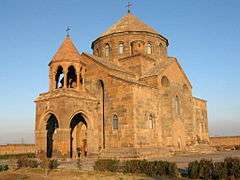Komitas Aghtsetsi

Komitas I Aghtsetsi (Armenian: Կոմիտաս Ա Աղցեցի) or Komitas I of Aghdznik (dead 628) also known as Komitas Shinogh ("builder")—an allusion to his many works of restoration and constructions.[1] Catholicos and Supreme Patriarch of All Armenians, poet and musician. He was instrumental in realization of several architectural projects. He completely renovated the Cathedral at the Holy See of Etchmiadzin and constructed the Church of St. Hripsime, which stands to this day. He also built the Church of St. Gregory in Dvin.
He was an Catholicos of Armenia and bishop of Taron from 615 through 628. He is also known to have been a hymn writer. He pulled down the original chapel and rebuilt the St. Hripsime Church at Etchmiadzin as it is seen today.
Komitas was also the editor of the collection of Armenian translations of patristic texts (including extracts from lost texts, e.g. Timothy Aelurus) known as the Seal of Faith.
A devout Catholic, he was never far away from disputes regarding the faith. He was a vociferous participant in doctrinal disputes. He sided with the orthodox school of thought of the Armenian Church during the Council of Ctesiphon (615–616). The Council concluded with the acceptance of Monophysitism; the Chalcedonian and Nestorian doctrines were renounced.[1]
His exceptional poetical and lyrical sharakan "Andzink nviryalk" ("Devoted souls") earned him a special place in the Armenian Church hymn-book. The 'Devoted Souls' was written as a eulogy to mark the completion of the Church of St Hripsime. The work marked not just the beginning of a new church but heralding a new age in Armenian spiritual literature. The work departed from previous sharakans in that it diverted from the tradition of dwelling on the Virgin Mary or The Bible. Instead, it spoke on subjects that were first raised in History, the celebrated work of the fifth-century Armenian historian Agatangeghos, which talks about Armenia's conversion to Christianity.[1]
References
- 1 2 3 Jack Hacikyan, Agop; et al. The Heritage of Armenian Literature: From the Sixth to the Eighteenth Century. Wayne State University Press. Retrieved 4 March 2013.
- Catholicos Komitas, Le sceau de la foi, Etchmiazin, 1914 (reimpression, Lisbon, 1974).
| Preceded by Abraham I of Armenia |
Catholicos of the Holy See of St. Echmiadzin and All Armenians 615–628 |
Succeeded by Christopher II of Armenia |